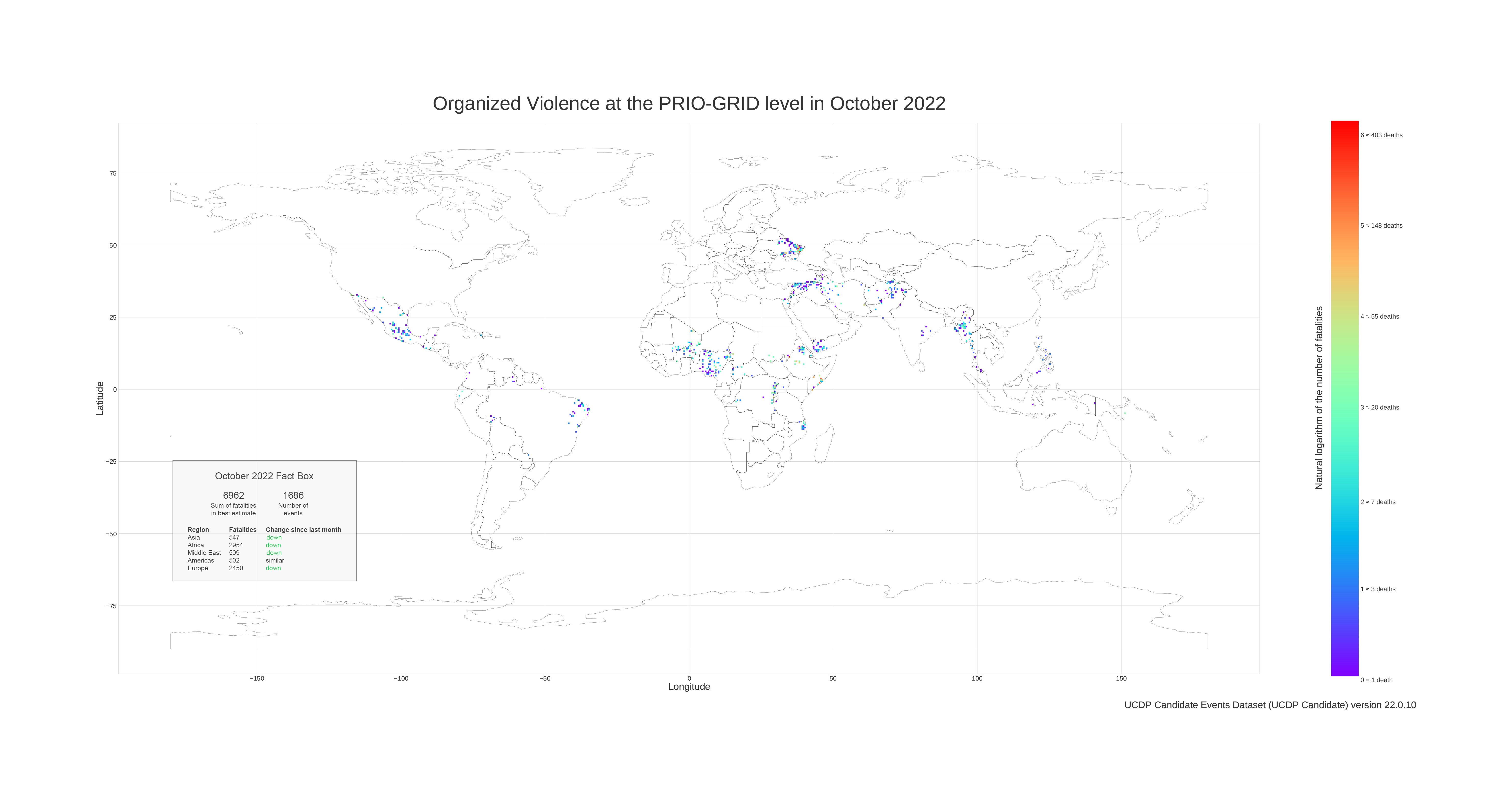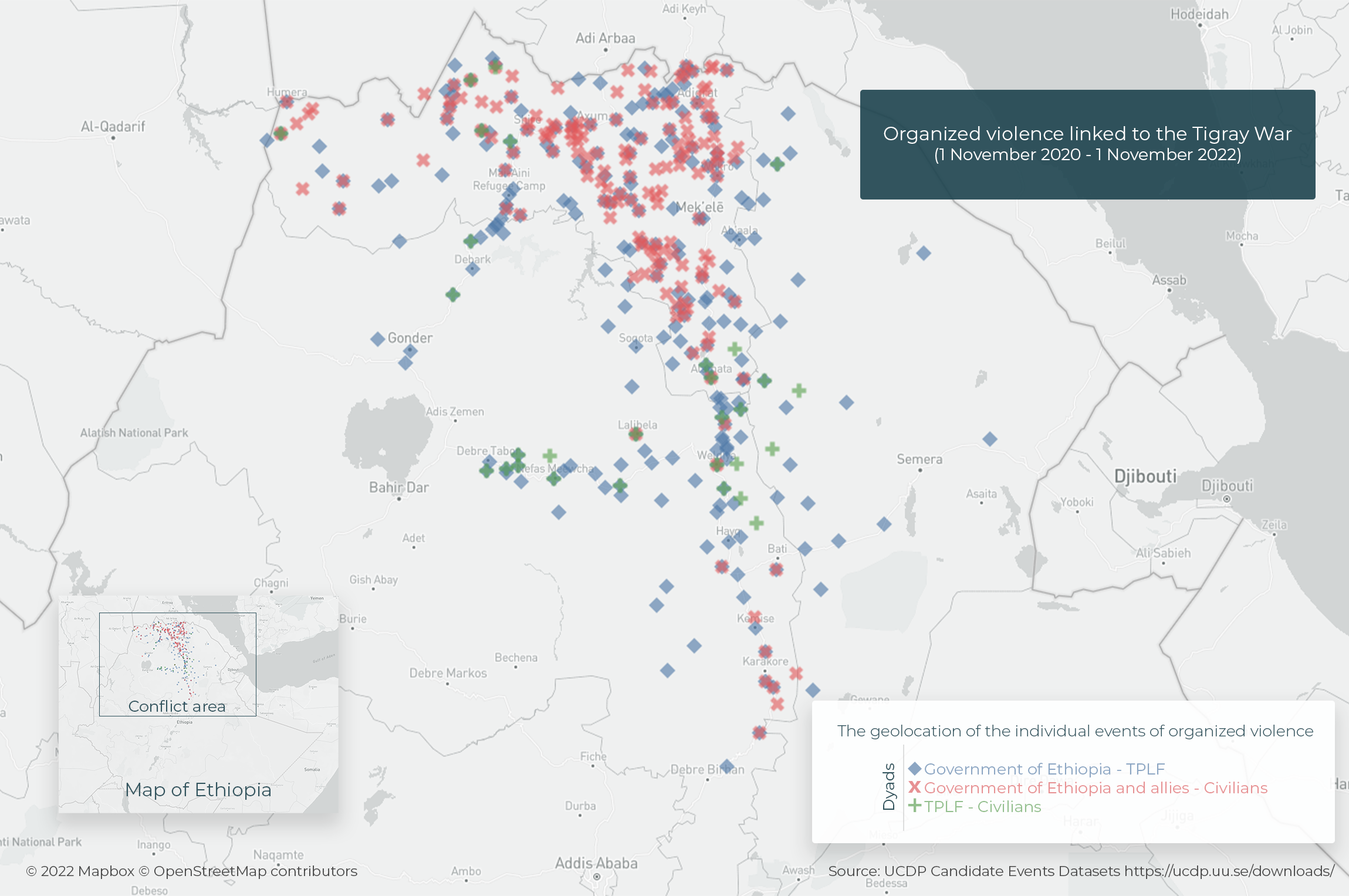|
UCDP Newsletter #9 |
THE WAR IN TIGRAY |
Staggering death toll in organized violence in Ethiopia |
Director's Note |
|
Welcome to the Uppsala Conflict Data Program (UCDP) Newsletter!
The first days of November 2022 marked both the second anniversary of - and a potential ending to the war in northern Ethiopia's Tigray region. On 2 November, the Ethiopian government and the Tigray People's Liberation Front (TPLF) signed a cessation of hostilities accord, which aims to serve as a starting point in a multi-step process to end the conflict. This came just a day before the conflict reached the two-year mark. With a number of contentious issues still outstanding, the fate of the accord remains unclear. Nevertheless, at the very least, it has resulted in a marked reduction in hostilities, providing much needed respite to the long-suffering civilian population.
The Tigray war has continuously failed to capture the international headlines. Fighting at a massive scale has persisted, far from the international spotlight, with diplomats, humanitarian sources and analysts with contacts in both camps holding the war to be among the most deadly today, comparable to and probably even surpassing the fatality numbers in Ukraine. Not even the fact that the rebel side at one point came within a mere 200 km from the capital, Addis Ababa, having fought its way south through the Amhara region, garnered widespread attention. All warring parties have committed atrocities on a massive scale, with the UN in September 2022 warning that they believed Ethiopia's government was behind ongoing crimes against humanity in the region. Below are some basic facts on one of the world's most deadly wars, played out in media's blind spot.
For any questions, suggestions, or comments, you may contact us at ucdp@pcr.uu.se.
Magnus Öberg UCDP Director |
|
Trends in Organized Violence in October 2022 |
|
Mert Can Yilmaz, Uppsala Conflict Data Program |
|
The fighting continued in eastern Ukraine in October 2022, causing at least 2300 fatalities.
The trends in Africa dominated the figures on the fatalities due to armed organized violence, while we noted a downward trend in every region when compared to September 2022, except for Americas where the intensity of violence remained at a similar level.
The five deadliest state-based conflicts in October were Russia - Ukraine, Somalia: Government, Ethiopia: Government, Myanmar: Government and Ethiopia: Oromiya.
Conflicts between Hausa and Funj communities in Sudan affected the trends in non-state violence in October 2022, causing at least 250 fatalities. The clashes between Jalisco Cartel New Generation and various other cartels in Mexico caused nearly 150 deaths during the month. Non-state violence in Brazil was also noteworthy during this month.
DR Congo was significantly affected by one-sided violence in October 2022 with over 200 civilians deliberately killed by organized actors. IS's one-sided attacks in DR Congo, Mozambique, Mali, Syria, Burkina Faso, Nigeria and Afghanistan caused almost 130 fatalities in total during this month. One-sided violence by the government forces in Iran was also noteworthy, resulting in the death of around 200 civilians. |
|
Source: UCDP Candidate 22.0.10 |
|
The War in Tigray |
|
Lotta Themner, Uppsala Conflict Data Program |
|
A conflict with many parties The conflict involves a number of actors, with the government side comprising both federal troops and regional forces from especially the Amhara region, as well as regional militia. Furthermore, Eritrea has sent troops, which have participated on the government's side. Altogether, these parties number more than 500 000. They are pitted against the TDF (Tigray Defence Forces), the armed forces of TPLF, with an estimated troop size of some 250 000.
Shifting fortunes of war After a period of increasing animosity and rising tensions between the central government in Addis Ababa and TPLF, the ruling party in the Tigray region, all-out fighting erupted on 3 November 2020. During the following two years, the fortunes of the war have shifted several times. Prematurely, the government declared victory already in later November 2020, having pushed TDF from all urban areas in the state. However, the rebels simply retreated to the mountains, where they re-grouped and by June 2021, they were able to push the government troops from regional capital Mekelle and then from the state altogether. TDF then went on to launch an offensive into neighboring Afar and Amhara region, capturing a string of towns on the road to Addis Ababa. It was not until late November that the government was able to halt the rebel advances, at which point TDF was only 200 km from Addis Ababa. Launching a counter-offensive, government troops subsequently pushed the group back into Tigray.
Aside from air- and drone strikes, the first seven and a half months of 2022 saw markedly lower levels of violence, amid attempts to resolve the conflict peacefully. However, in late August, the war resumed yet again, and September and October saw large-scale fighting, with TDF initially gaining the upper hand, seizing a number of towns in northern Amhara region. However, a joint Ethiopian and Eritrean offensive from Eritrean territory forced TDF to withdraw from Amhara to protect its rear, and from mid-October the rebels lost a string of urban centers, seemingly shifting into guerrilla warfare yet again, some weeks prior to the signing of the cessation of hostilities agreement.
Staggering death toll Much of the conflict has played out as a bloody infantry war on several fronts, where both sides have been accused of using recently recruited fighters as cannon fodder, launching human wave attacks through mined areas towards enemy trenches. Resembling WW1 fighting, and previously used in the interstate war between Eritrea and Ethiopia, the idea behind this tactics is that the sheer number will result in those defending eventually running out of ammunition. By its nature, this type of warfare causes massive death tolls, and estimates of the total number of fatalities in the war is staggering, ranging between 50 000 and 500 000.
Civilian targets of atrocities In addition to battlefield deaths, innumerable civilians have been targeted and killed in large-scale atrocities. With limited access to the region, far from all alleged crimes have been investigated, but based on reports so far, the UN has stated that violations by all parties may amount to crimes against humanity and war crimes. Furthermore, Human Rights Watch and Amnesty have accused federal troops and Amhara regional forces and militia of ethnic cleansing of Tigrayan civilians in the disputed Western Tigray zone, which is also claimed by Amhara state. |
|
The Uppsala Conflict Data Program (UCDP) is the world's main provider of data on organized violence and the oldest ongoing data collection project for civil war, with a history of almost 40 years. Its definition of armed conflict has become the global standard of how conflicts are systematically defined and studied. |
|
UCDP Uppsala Conflict Data Program ucdp.uu.se |


